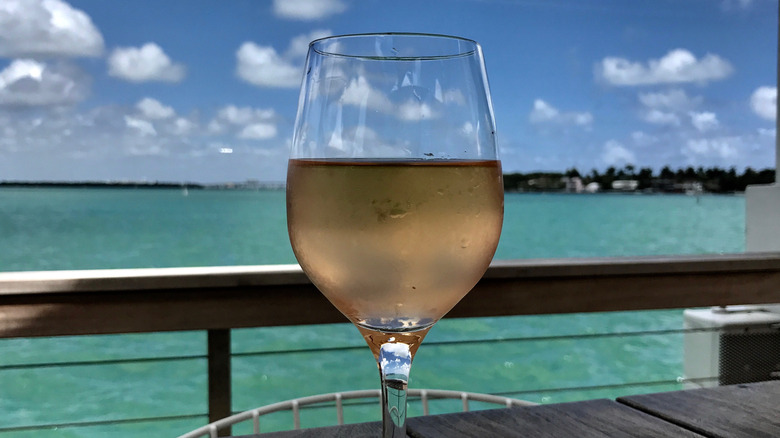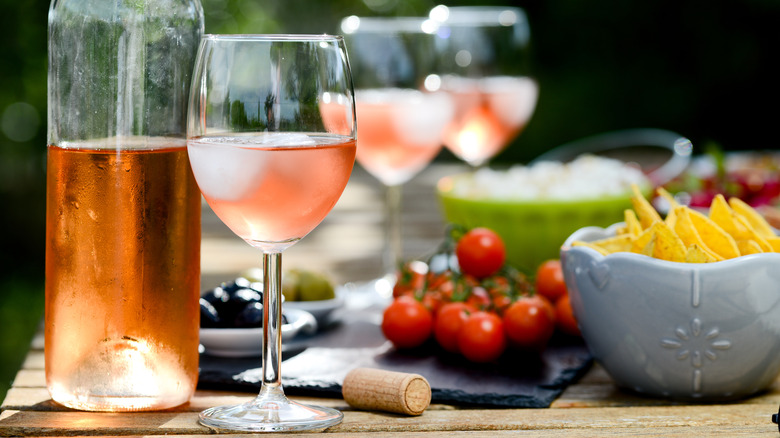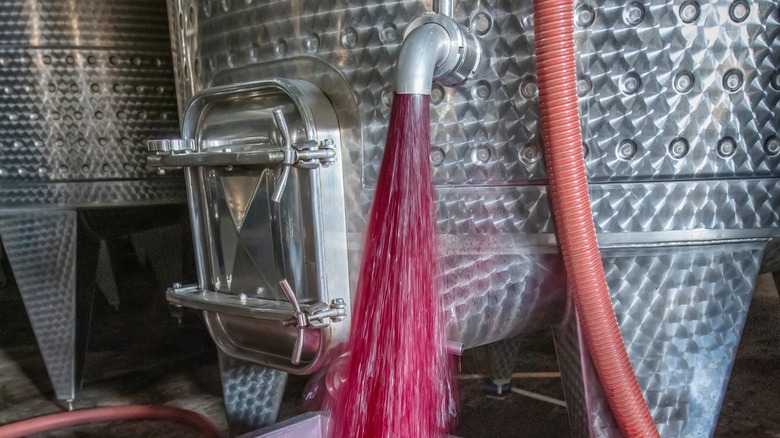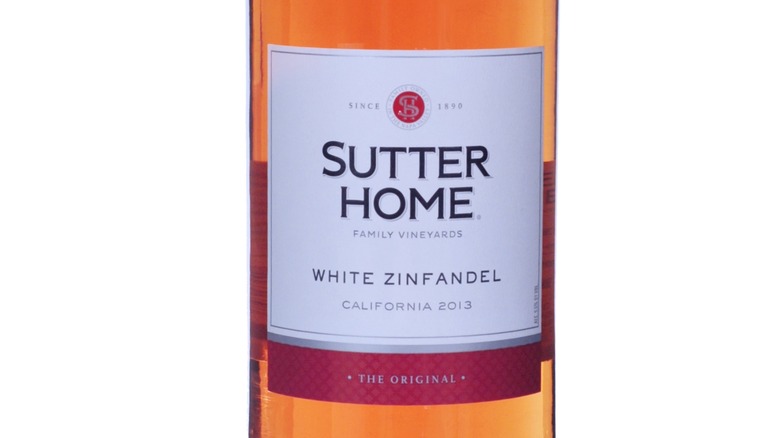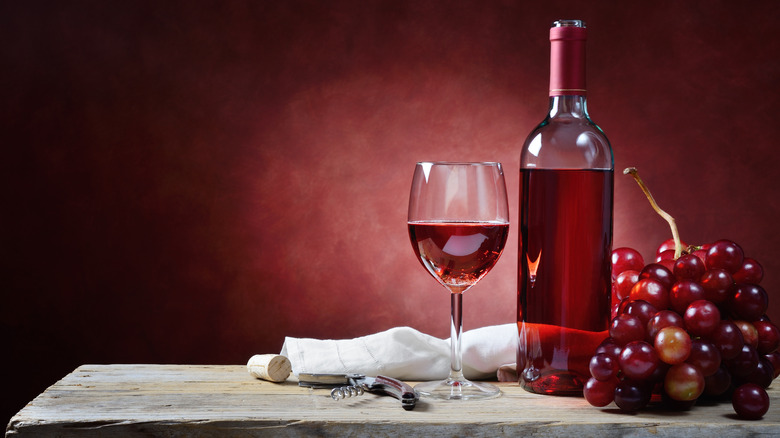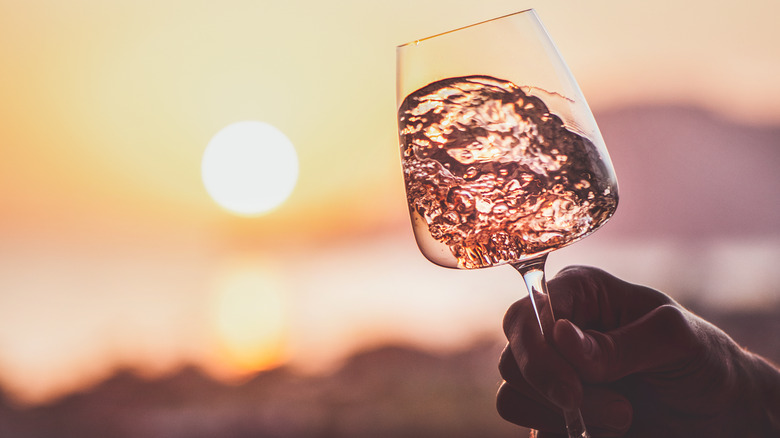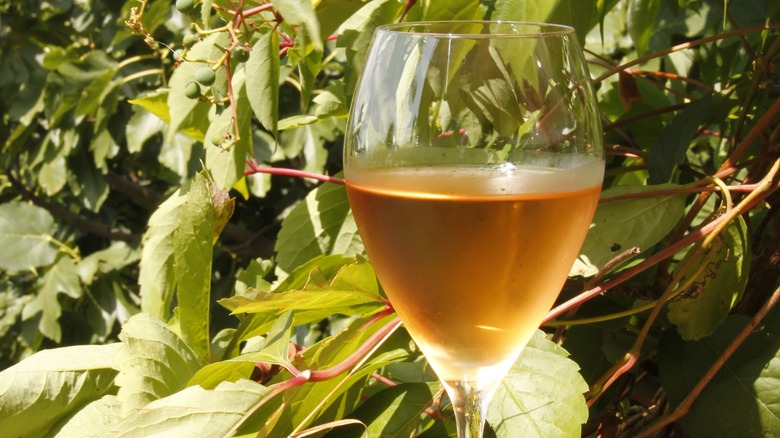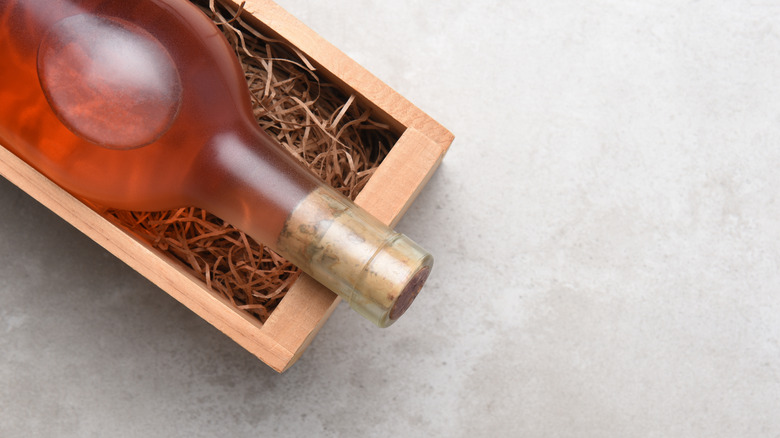12 Different Types Of Rosé Explained
No one expected the pink wave that crashed onto the wine scene the past decade or so. Once scoffed at and thought of as an inferior product, rosé has taken the world by storm. The velocity of rosé growth, according to Bevalc Insights, is forecasted to rise by almost 70% from 2020 to 2024. Consumers pay more per bottle each year, paving the way for premiumization in the rosé category. Celebrities like Bon Jovi, John Legend, Brad Pitt, Angelina Jolie, and Post Malone have contributed to the rise of rosé as a luxury product with their own brands. The IWSR says the category will only grow as celebrities continue to launch products, broadening the demographic. Plus, with events and movements popping up like National Rosé Day, it's safe to say the rosé trend isn't going anywhere.
Rosé is made in a few different ways, such as the saignée method, direct pressing, blending, and limited skin maceration, according to VinePair. The saignée method occurs during the process of making red wine. Some of the juice is bled off before it has had too much contact with the skins. The separated juice is vinified into rosé before the rest continues contact with grape skins to make other major types of red wine. A direct press method when a delicate and pale wine is the desired outcome and is done by softly pressing the grapes until the free-run must (juice) is extracted. Limited skin maceration is when the grapes are destemmed, crushed, and left to sit on the skins for hours or up to two days, depending on the intended hue and phenolics. A blended rosé is the easiest to understand; it is mixing red and white wine, which you can do in your kitchen!
Provençal
Provence and rosé go together like Japan and sushi — you can't think of one without the other. The ballerina slipper-hue of rosé made in this coastal region of Southwest France is striking against a backdrop of turquoise waters. As a wine region, Provence dedicates 91% of hectares of vines for rosé (per Vins de Provence). The grapes used in a rosé from Provence are usually a blend of mourvèdre, syrah, grenache, cinsault, carignan and cabernet sauvignon. And while rosé might seem like a newer concoction, The Good Life France says that rosé was produced in Provence 2,600 years ago.
Although rosé production ramped up in many European countries during the 1990s, it was still considered tacky and uncivilized in the U.S., possibly due to the onslaught of terrible white zinfandel that had torn through the country in the 1980s. But over time, the perception has started to change — this isn't the same syrupy pink swill from decades past. Rosé from Provence was the first style to gain popularity in the States. Its pale pink hue, racy acidity, and soft flavors of strawberry, peach, and watermelon with an edge of minerality began to win over not just consumers but wine connoisseurs as well. Now, you would be hard-pressed to find a winery that doesn't make a rosé. Vins de Provence tells us that the market for Provençal rosé has grown by 500% in the last 15 years.
Sparkling
From rosé Cava, Prosecco, Champagne, Méthode Cap Classique, nearly every type of sparkling wine has a rosé version. Each one differs depending on the production method and where it is crafted.
For a wine to be Champagne has to be made in the Champagne region of France. To turn a Champagne into a rosé, pinot noir and pinot Meunier are added through the saignée method and then finished using méthode champenoise. In this unique process, the second fermentation happens in the bottle. The outcome is a creamy, rich sparkler with fresh red berry notes, a hint of limestone, and an autolytic character — think brioche or toast.
Cava, produced in the Cava region of Spain, is also produced in the méthode champenoise. Because of this, it will have a similar mousse (texture of the bubbles) and an autolytic note. However, being by the sea gives Cava a bit of brininess or salinity. The grapes in a rosé can be garnacha, monastrell, pinot noir, and trepat, according to D.O. Cava. It has a creamy mouthfeel with bright, red berry fruit with jasmine flowers and savory herbal notes.
South African sparkling wines produced using méthode champenoise are referred to as Méthode Cap Classiques, typically abbreviated as MCC. Vinovest tells us that MCC wines are usually produced using the classic Champagne blend of pinot noir, chardonnay, and pinot Meunier, although winemakers are not beholden to that blend. The can be described as having aromas of orange blossom, lemon zest, toasted bread, and macadamias, with hints of lime on the palate. They will display zippy acidity and a delicate mousse.
In spring 2020, Vinepair was eager to announce that the region of Prosecco unveiled a new designated sparkling rosé denomination. Prosecco is not made in the méthode champenoise. Instead, it is created in the Charmat method, which MasterClass defines as a process of carbonating wine in large steel tanks. This method provides crisp fruit-forward wines because there is no autolysis. The result is bright and lemony, brimming with fresh peach. The addition of pinot noir adds a wild strawberry note.
Vin Gris
Meaning "gray wine," according to VinePair, vin gris is a pale pink rosé made using very little maceration time (the time the juice is left on the skins). Vin gris is fermented in stainless steel rather than oak so that the delicate flavors are not overpowered. It is typically made with pinot noir, gamay, or grenache, but it is not regulated to adhere to any specific varieties. This style originated in France but is made in many other regions.
Vin gris is not a style you will come across often as it isn't well-known in the United States yet. But, according to Matador Network, it is all the rage in Morrocco. Not only has it become a popular wine with consumers, but Moroccans are producing vin gris themselves. This demure style of rosé displays all the features rosé drinkers love, such as strawberry, peach, and watermelon flavors, fresh acidity, and a crisp, light body are all present — just toned down. Matador Network states that in Marrakech, vin gris is enjoyed alongside oysters or a bowl of harira, the local bean soup.
Tavel
Tavel is on the opposite spectrum of vin gris. It is deep and brooding in color and anything but delicate in taste. As most French wines are denominated by region, Tavel is no different. Tavel comes from the Tavel region of France in the Southern Rhône area. Wine Searcher tells us that Tavel rosés are made of three Rhône region grapes — grenache, syrah and clairette.
This wine gets its deep color from extended maceration with skins, adding a tannic structure not found in most rosés. Tannins in wine come from grape skins, pips (seeds), and oak from oak barrels. This is why red wines are very high in tannins, and white wines are not; in the white wine-making process, the juice does not have contact with the skins, per Wine Enthusiast.
Tavel's robust body, textural mouthfeel, and abundant aromas and flavors make this a rosé that can be enjoyed with heartier meals. While they are still refreshing and juicy enough for a day at the beach or a picnic, they can also fit into winter activities. Tavel rosés will classically have notes of redcurrant, cassis, cranberries, and spice that align with various fare and situations.
Saignée
Less of a style and more of a method, saignée is how some of the most brooding and darkest rosés are produced. If that doesn't sound goth enough, wait until we explain how it's done. According to Wine Folly, rosés made in saignée fashion are done by "bleeding" off some of the juice during red wine production after the liquid has had some time in contact with the skins and seeds. The connection with skins increases the concentration of color, texture, and flavors. The longer the contact, the deeper the concentration. This could be anywhere from two hours to two days.
Saignée styles of vino are made in many wine regions, and the characteristics will differ depending on where the wine is produced and which grapes are used. Still, Recette Magazine explains that saignée wines are generally fruit-forward and tangy with strong savory notes. Consumers can expect strawberries, licorice, cherry, raspberry, and pink peppercorn notes. Since this is a bolder style, it can be enjoyed all year round, holding its own when paired with the richest meals.
White Zinfandel
Ah, white zin, the pink-headed stepchild of wine. White zinfandel flooded the markets in the 1970s and 1980s with its syrupy sweetness. It all came to be by accident, according to VinePair. In an attempt to intensify his zinfandel's tannic structure, Bob Trinchero (owner of Sutter Home in California) skimmed 500 gallons of juice off of grape skins when they were soaking so that the juice remaining would have more skin contact. Trinchero decided to bottle the pink juice he pulled off and called it white zinfandel. This first iteration was a dry white zinfandel — a classic rosé. The white zin we know to be a sugar monster came later. In 1975, Sutter Home Wineries experienced a stuck fermentation while making its white zinfandel. A "stuck fermentation" is when sugars are left behind during fermentation due to the yeast dying before converting the sugar to alcohol. What was left behind in Sutter Home's stuck process was the sweet rosé we know today as white zinfandel.
The new fashion of rosé became a raging success for a while, at least until the public moved away from the syrupy style, opting for a dryer wine. Today, some producers are trying to change the perception of white zin with hipper iterations, such as Monte Rio Cellars, which makes a bone-dry white zinfandel, or Broc Cellars with its high-acid version.
Bandol
Bandol is almost like a cousin of Tavel — they are both from France and super deep in color and expression. Bandol is an appellation in Provence, but its style is far from the soft pastel pinks typical of Provence. These rosés are produced by direct press, allowing for extra skin contact, which gives them an intense hue. Wine Searcher explains that Bandol rosé wine is known for its tannic structure and spicy flavors. Ripe strawberry, tart cherry, and orange peel are other notes that might come through.
These wines are made from a blend of Mourvedre, Grenache, and Cinsaut. They are considered upscale rosés and gastronomic accompaniments. According to Wine Searcher, the Count of Monte Cristo enjoyed a glass of Bandol rosé in Alexandre Dumas's novel. Marvellous Provence ups the ante by claiming Bandol wines were relished at the French court by Louis XV himself. As legend would have it, when was asked the secret of his youth and vigor, King Louis replied, "The wines of Bandol." Sacré bleu!
Tempranillo Rosé
Hailing from Spain and making up most of the red wines in Rioja and Ribera del Duero, tempranillo is also the grape many Spanish wineries use to make rosés (or rosado as it is locally called). Rosado can be crafted in several ways. In terms of fermentation, winemakers can employ short maceration or direct press. Regarding aging, some rosados are aged in stainless steel to preserve the vibrant fruit, while others might spend some time in oak to give a more complex character (via Foods and Wines from Spain). In fact, in Rioja, the aging requirements for red wines are also followed in rosado production. According to Wine Enthusiast, each rosado will get a designation depending on the amount of time spent in oak — Joven (no aging requirement); Crianza (aged for 12 months, with six months in barrel); and Reserva (two years with six months in barrel).
Most of these rosés will have the hue of onion skin, but deeper pink wines are called "claretes." Spanish tempranillo is well-known for big, powerful notes of dark fruit, and mouth-drying tannins, according to Wine Folly. These aspects account for the bold styles of rosé produced from tempranillo. Most will have notes of strawberry, raspberry, white flowers, and an herbal underpinning, with possible toasty accents depending on oak aging. Wineries worldwide — from Sonoma to Australia to New Zealand — are trying their hands at a rosé made from tempranillo.
Pinot Noir Rosé
It's hard to top pinot noir when it comes to refreshing and fruity feels. Its suggestive acidity and fresh notes of watermelon, strawberry, and bing cherry lend themselves beautifully to a rosé. This is why Titus Andromedon wrote his ode to the grape in "Unbreakable Kimmy Schmidt." Okay, that was actually an ode to something else but should write someone write a song about pinot noir rosé, they might have a hit because this wine is bonkers good.
Many winemaking regions create rosé from pinot noir, but the most prominent areas are Burgundy and the Loire Valley in France, the Willamette Valley in Oregon, New Zealand, and cooler areas of California like Mendocino County, Santa Barbara County, and Sonoma County (via Eater). This finicky grape thrives in cooler climates where it can retain its delicate body and acidity can reach its full potential. Diurnal shifts also come into play in ripening pinot noir to perfection. Wine Dialogues describes diurnal shifts as a huge change in temperature. For example, in the Russian River Valley (in Sonoma County), the high daytime temps can fall by as much as 40 degrees at night. The grapes ripen during the day and then rest at night (sleep is very important!), providing a longer, slower growing period that leads to pinot noir's elegant expression.
Pinot noir fits all the boxes for a great rosé grape. Zippy acidity — check. Bright, fresh fruit — check. Delicate and light body — check. If you are still not convinced, here is an in-depth look at why you should try rosé that is crafted purely from pinot noir grapes.
Syrah Rosé
Savory and rich, rosés made with syrah (or shiraz as it's called in Australia) are anything but demure. The color will typically be darker than its Provençal or pinot noir counterparts. White pepper, green olive, strawberry, cherry, and peach are classic notes that can be found in a syrah rosé, according to Matthew Clark.
The regions championing syrah are the Rhône Valley and Languedoc-Rousillion in France, and Australia — especially Barossa. Jancis Robinson tells us that South Africa, Chile, Spain, and California wineries are also getting in on the action. While it is used in rosé blends in Tavel and Provence, many producers find that a single-varietal syrah rosé is the way to go for a bold expression. These wines don't have to be reserved for poolside cheers and barbeque pairings — they can stand up to the heartiest stews and richest risottos because of considerable heft. If the thought of drinking a chilled beverage during cold months does not appeal to you, fear not. Masterclass suggests that hosts needn't serve this style of rosé cold. A naturally high alcohol level will certainly warm you up!
Cabernet Sauvignon Rosé
Rosé made from cabernet sauvignon has a long history. While many regions offer a rosé from cabernet sauvignon these days, Wine Spectator tells us that the combination first took off in 1976, when wine writer Jerry Mead was visiting Mill Creek Winery in Sonoma winery. Owner Bill Kreck tasted him on his pale pink cabernet sauvignon. Bolder than a typical rosé, he had been calling it "blanc de noir" (white from black). When Mead saw it, he suggested the name be cabernet blush. The name caught on, and other wineries began bottling "blush" wines. The term isn't used so much these days as it eventually came to connotate a sweet pink wine.
Today, rosés produced with cabernet sauvignon are called just that. California still produces a number of cabernet sauvignon rosés, ranging in styles from bone dry to sweet. Cabernet sauvignon is one of the main grapes used in a red Bordeaux blend (which also includes merlot and cabernet franc), and the rosé produced from these grapes is no different. Other regions such as Chile, Australia, and South Africa have had much success with output of cabernet sauvignon rosés. Mulderbosch in Stellenbosch, South Africa, has been making rosé in this style since 1999. They pick the grapes early to preserve the natural acidity that is inherent to the fruit.
The cabernet sauvignon style of rosé will differ depending on where it was crafted and the treatment with which it was produced. However, most will display a nice tannic structure, notes of cassis and bramble, and a deep color.
Sangiovese Rosé
In Italy, sangiovese is used to produce Chianti, Vino Nobile di Montepulciano, super tuscans and Brunello, per Wine Searcher. The grape is known for its earthy and rustic characters, firm tannins, and high acidity. This translates well into a lively rosé, which in Italy is called rosato. According to Matthew Clark, a sangiovese rosé will have a bright hue and a medium-dry sweetness level. Strawberries, roses, sweet cherries, and peach will come through on the nose and the palate. Sangiovese classically has a savory backbone, which will also express itself in a rosé.
Italy isn't the only region having fun with sangiovese rosé. Australia, California, and Washington are taking advantage of how nicely this grape expresses itself as a rosé. Wine Australia explains that 40 years ago, Australia began to produce sangiovese in its own style, and production has been ramping up ever since. While Australia and sangiovese are not synonymous, wine professionals and consumers alike have begun to take note. Of course, many of these producers use the grape to make a rosé that is especially enjoyable in the hot Aussie sun.

